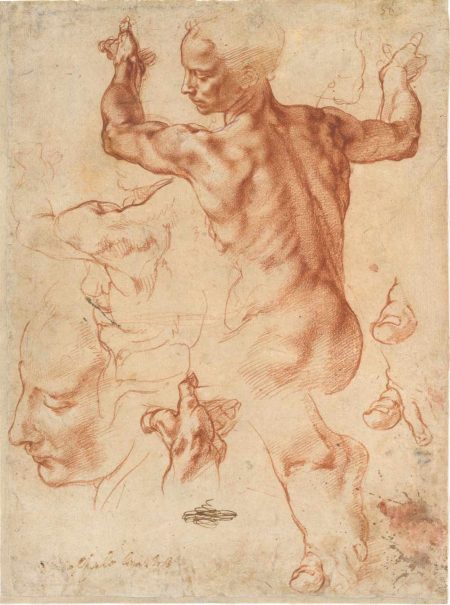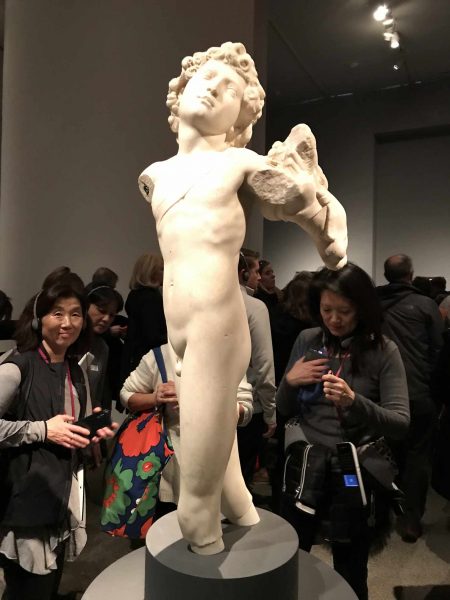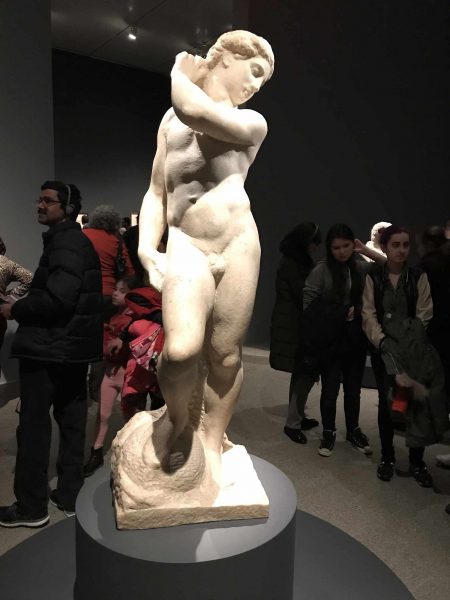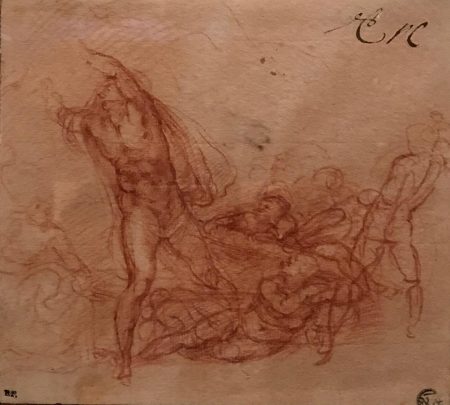
“Five hundred years seem to melt away in looking at his art.”1 Over and over again, critics in the United States and elsewhere referred to this magnificent exhibition as a once-in-a-lifetime-opportunity and they were absolutely correct. The exhibition opened in November to great fanfare and concluded with continuous packed gallery attendance as the exhibit drew to a close in February 2018.
Art curators continuously investigate the art work and the lives of famous artists to shed light on previously unknown information, or to expand or redirect the analytical response to the artist. The Taft Museum in Cincinnati did this brilliantly in its 2015 Daubigny, Monet, Van Gogh: Impressions of Landscape exhibit and so did the Cincinnati Art Museum in its recent Van Gogh: Into the Undergrowth. So the Metropolitan Museum of Art in New York gives us a reexamined Michelangelo.
Drawings are the magnificent centerpiece here for an artist long-celebrated for his astounding sculptures and triumphant Sistine Chapel ceiling mural painting. With over 700,000 visitors to see Michelangelo: Divine Draftsman and Designer, this Met exhibition is the 10th most visited among such Met blockbusters as Mona Lisa in 1963, Treasures of Tutankhamun in 1978, and Picasso in The Metropolitan Museum of Art in 2010. In the Met’s 148-year history, it is also the most visited drawings exhibition ever organized by the Museum.” 2
Michelangelo is a towering genius in the history of Western art, and during his rich and long life, as curator Carmen Bambach states: “Michelangelo was celebrated for the excellence of his disegno, the power of drawing and invention that provided the foundation for all the arts. For his mastery of drawing, design, sculpture, painting, and architecture, he was called Il Divino (“the divine one”) by his contemporaries. His powerful imagery and dazzling technical virtuosity transported viewers and imbued all of his works with a staggering force that continues to enthrall us today.”

Exhibition eight years in the making.
One-hundred thirty-three of Michelangelo’s original drawings are on display from collections including The Vatican, The Louvre and The Royal Collection of Queen Elizabeth II.
Three of his original marble sculptures are included to provide context.
Michelangelo’s earliest painting is there.
Michelangelo’s actual wood architectural model for a chapel vault is included.
Michelangelo’s poetry, usually written on sheets with studies, is also in this show.
A substantial body of complementary works by his teachers, associates, pupils, and artists who were influenced by him or who worked in collaboration with him was also displayed for fabulous comparison and context. We discover how he interacted with his peers and how in-demand he was during his long and prolific life.
The exhibition brought together the largest group of original drawings by Michelangelo ever assembled for public display.
“Michelangelo Buonarroti was born on March 6, 1475 in Caprese (southeast of Florence), and died a wealthy and famous man, on February 18, 1564, in Rome. Although he spent the last 30 years of his life in Rome, his love was always for Florence, his patria (homeland), and all things Florentine. His art, his training, his methods, and his poetry were, to the last, rooted in Florentine culture. Michelangelo’s longevity was extraordinary for a person of his time. Also exceptional for an artist of his era, five major biographies were written during his lifetime or soon after his death.”3
Great and exhaustive research – and the research and preparation for this magnificent exhibition was great – yields many surprises. So we think we know Michelangelo? We all know of his magnificent over- scaled statue of David in Florence. We know of the Sistine Chapel frescoes in The Vatican in Rome. It is an extreme rarity that we are treated to his cartoons – full-scale drawings intended for a painting he planned to execute or as a commission he accepted to make the full-size drawing for another artist to paint. For example, the monumental panel painting of Venus Kissed by Cupid, on loan from the Galleria Colonna in Rome, is not by the hand of Michelangelo himself, but is based on a design Michelangelo made in the early 1530s for a specific commission in Florence. The cartoon served as the final model for the artist Jacopo da Pontormo, who executed it in oil on panel and finished it around 1533.
Pontormo’s painted version of Michelangelo’s Venus Kissed by Cupid is so famous that it is in most art history surveys, and it is referenced by art biographer Giorgio Vasari (1511–1574). As would be expected, it was instantly popular (a Klimt’s Kiss for the 16th century). There are at least 32 versions and replicas of varying sizes and quality that were created over the following decades. Since several of these replicas have the exact measurements as the original it suggests the artists had access to the original cartoon by Michelangelo. So we know that Michelangelo was a prolific genius in both painting and sculpture, but we see them together for the first time with the drawings and cartoons in his additional role as designer.
Michelangelo was serving numerous masters in the demands made upon him by the Papacy and by the aristocracy, not to mention the fact that as he aged, he could depend on his formidable skill as draughtsman, and leave the time-consuming execution of a painting to other artists. In this area, so much is new, seeing a substantial body of artworks by his teachers, associates, pupils, and artists who were influenced by him or who worked in collaboration with him. Michelangelo was part of a vibrant cultural community in Florence and Rome, so to see art works done in the same time period by colleagues and collaborators enriches our understanding of the genius and those who found themselves in his orbit.

The exhibition’s first rooms reveal his early art works and three sculptures the artist carved in marble from Carrara, including the monumental, unfinished Apollo-David. Michelangelo was extremely hands-on by nature so he worked at the quarries in Carrara and Pietrasanta, to be able to select specific marbles and to give precise orders regarding the sizes and shapes of the blocks he wanted quarried. It is amazing to think of this, but he also got involved with the building of roads to transport the stone back to his studio or site where the sculpture would reside. All of this is brought into focus by a rare letter in the Met’s exhibition, written by Michelangelo in Florence to his servant Pietro Urbano, who managed his household and who often worked for the master at the marble quarries in Carrara. The letter is business-like in tone, but since Michelangelo reused a sheet with his drawings to write to him, the sheet is presented to view both sides. We can marvel at how prolific Michelangelo was in drawing that he could turn over a sheet of sketches and on the verso dash off a letter to his assistant.
Examining his drawings, one hundred thirty-three of them, we come away with a full knowledge of his pure love of drawing. Drawing radiated from his soul and this is apparent in every drawing he made. A number of his Resurrection drawings are in the exhibit, all exquisite. Tenderness, passion, and a struggle to show the magnitude of the event are evident in the red chalk lines. In the drawing reproduced here in this article, the miraculously risen Christ is virile and muscular; he is neither the attenuated Christ on the cross nor the risen Spirit, but a robust nude man. It is curiously at odds with the kinds of Resurrection drawings we are familiar with and which the Catholic Church used to promote an asexual Christ. This Resurrection reveals the individuality of Michelangelo’s vision.

There are simply not enough varied superlatives for “genius,” “masterful,” “exquisite,” and such, as in viewing the celebrated black chalk drawing of Cleopatra and one of Queen Zenobia that I had never seen. So I leave you with my suggestion to go see in person important exhibitions that speak to you. You will be rewarded for the time and money spent to do so.

1 Dr. Carmen C. Bambach, Metropolitan Museum of Art Press Room.
2 Metropolitan Museum of Art Press Room.
3Metropolitan Museum of Art Press Room.
All photos by author except Libyan Sibyl, provided by MMA Press Room. The authored was approved for taking photographs.
–Cynthia Kukla